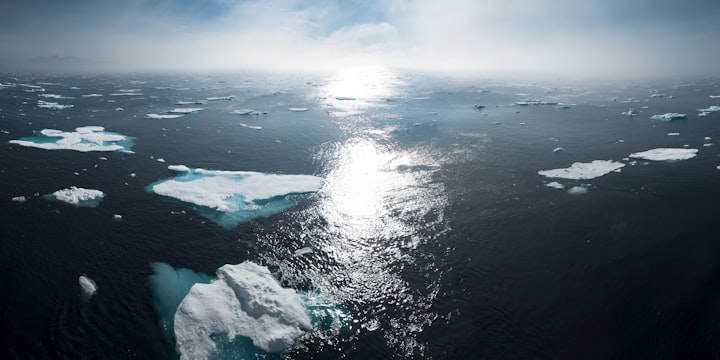Climate Change: Understanding the Phenomenon, Impacts, and Solutions
Extreme Weather Events: Climate change amplifies the frequency and intensity of extreme weather events such as hurricanes, cyclones, floods, and droughts, leading to significant economic losses and human casualties.

1. Causes of Climate Change:
1.1. Greenhouse Gas Emissions: The primary driver of climate change is the accumulation of greenhouse gases (GHGs) in the atmosphere. Activities such as burning fossil fuels (coal, oil, and natural gas) for energy, deforestation, industrial processes, and agriculture contribute to elevated GHG concentrations.
1.2. Deforestation: Forests act as carbon sinks, absorbing and storing carbon dioxide (CO2) from the atmosphere. However, widespread deforestation reduces this capacity, leading to increased CO2 levels and contributing to climate change.
1.3. Industrialization: The rapid growth of industrial activities since the 19th century has released significant amounts of GHGs, including CO2, methane (CH4), nitrous oxide (N2O), and fluorinated gases, into the atmosphere.
1.4. Agriculture: Agricultural practices like livestock farming and rice paddies produce methane, while the use of synthetic fertilizers releases nitrous oxide, both potent greenhouse gases.
2. Impacts of Climate Change:
2.1. Rising Global Temperatures: The Earth's average temperature has been steadily increasing over the past century. This warming trend leads to more frequent and intense heatwaves, exacerbating heat-related illnesses and causing stress on ecosystems.
2.2. Extreme Weather Events: Climate change amplifies the frequency and intensity of extreme weather events such as hurricanes, cyclones, floods, and droughts, leading to significant economic losses and human casualties.
2.3. Melting Glaciers and Rising Sea Levels: Global warming causes glaciers and polar ice caps to melt, contributing to rising sea levels. This poses a substantial threat to coastal communities and low-lying islands, increasing the risk of flooding and saltwater intrusion into freshwater sources.
2.4. Ocean Acidification: As the ocean absorbs excess CO2 from the atmosphere, it becomes more acidic. This has detrimental effects on marine ecosystems, particularly coral reefs and shell-forming organisms, disrupting marine biodiversity and fisheries.
2.5. Biodiversity Loss: Climate change disrupts ecosystems and habitats, leading to species migration, extinction, and altered ecosystem functions. This loss of biodiversity has cascading effects on the entire ecosystem and reduces resilience to environmental changes.
2.6. Human Health: Climate change affects human health through heat-related illnesses, vector-borne diseases, reduced air and water quality, and malnutrition due to changing agricultural conditions.
3. Mitigation Strategies:
3.1. Transition to Renewable Energy: Shifting from fossil fuels to renewable energy sources like solar, wind, hydro, and geothermal power can significantly reduce GHG emissions and decrease reliance on finite resources.
3.2. Afforestation and Reforestation: Planting trees and restoring degraded forests help sequester carbon dioxide, mitigating climate change and enhancing biodiversity.
3.3. Energy Efficiency: Improving energy efficiency in buildings, transportation, and industries can reduce energy consumption and associated GHG emissions.
3.4. Sustainable Agriculture: Implementing sustainable farming practices, such as organic farming, agroforestry, and precision agriculture, can lower agricultural emissions and enhance carbon sequestration in soils.
3.5. Carbon Capture and Storage (CCS): CCS technologies capture CO2 emissions from industrial processes and power plants and store them underground, preventing their release into the atmosphere.
3.6. Climate Policy and International Cooperation: Governments must adopt ambitious climate policies and collaborate internationally to set emission reduction targets and hold countries accountable for their contributions to climate change.
Conclusion:
Climate change is a multifaceted global crisis that requires urgent action and collective responsibility. By understanding its causes, impacts, and available mitigation strategies, we can work together to mitigate its effects and create a sustainable future for generations to come. Transitioning to a low-carbon economy, protecting natural resources, and fostering international cooperation are essential steps toward tackling the challenges posed by climate change and securing a better world for all living beings.Climate change, one of the most pressing global challenges of our time, refers to long-term shifts in weather patterns and average temperatures on Earth. Over the past century, human activities, particularly the burning of fossil fuels and deforestation, have significantly contributed to the increasing concentration of greenhouse gases (GHGs) in the atmosphere. These gases, including carbon dioxide (CO2), methane (CH4), nitrous oxide (N2O), and fluorinated gases, trap heat from the sun and lead to global warming, resulting in various climatic changes and environmental consequences. This article delves into the intricacies of climate change, its impacts on the planet and humanity, and the potential solutions to address this existential crisis.
The Science of Climate Change
Greenhouse Effect: The greenhouse effect is a natural phenomenon that keeps the Earth warm enough to support life. Solar radiation reaches the Earth's surface and some is absorbed while the rest is re-emitted as heat. GHGs in the atmosphere trap a portion of this heat, preventing it from escaping back into space, thus maintaining the Earth's average temperature around 15°C (59°F). Without the greenhouse effect, our planet would be too cold to sustain life.
Anthropogenic Climate Change: The Industrial Revolution marked the beginning of significant human-induced climate change. The combustion of fossil fuels (coal, oil, and natural gas) for energy, deforestation, agriculture, and industrial processes have released excessive GHGs into the atmosphere, enhancing the natural greenhouse effect and leading to an unprecedented rise in global temperatures.
Evidence of Climate Change
Temperature Rise: Over the past century, the global average temperature has increased by approximately 1.2°C (2.2°F) above pre-industrial levels. This rise in temperature has led to more frequent and intense heatwaves.
Melting Ice and Rising Sea Levels: The Arctic sea ice has been declining at an alarming rate, with the summer minimum extent reaching record lows. Additionally, glaciers and ice sheets in Antarctica and Greenland are melting at accelerated rates, contributing to rising sea levels, threatening coastal communities and low-lying islands.
Extreme Weather Events: Climate change is linked to an increase in extreme weather events, such as hurricanes, cyclones, droughts, floods, and wildfires, causing immense damage to ecosystems, infrastructure, and human lives.
Ocean Acidification: The absorption of excess CO2 by the oceans has led to increased acidity, threatening marine life, particularly coral reefs and shell-forming organisms.
Impacts of Climate Change
Biodiversity Loss: Climate change disrupts ecosystems, leading to the loss of habitats and threatening many species with extinction.
Agricultural Challenges: Changes in temperature and precipitation patterns affect crop yields, food production, and food security.
Water Scarcity: Changing weather patterns and melting glaciers contribute to water scarcity in some regions, leading to conflicts over water resources.
Health Consequences: Extreme heat, changing disease patterns, and impacts on air and water quality can harm human health, especially vulnerable populations.
Economic Disruptions: Climate-related disasters can cause substantial economic losses, affecting industries, jobs, and infrastructure.
Mitigation Strategies
Transition to Renewable Energy: Shifting from fossil fuels to renewable energy sources, such as solar, wind, hydro, and geothermal, is crucial in reducing GHG emissions.
Energy Efficiency: Improving energy efficiency in buildings, transportation, and industries can significantly reduce energy consumption and emissions.
Afforestation and Reforestation: Planting trees and restoring forests help absorb CO2 from the atmosphere, acting as a natural carbon sink.
Sustainable Agriculture: Implementing sustainable farming practices reduces emissions and increases resilience to climate change impacts.
Carbon Capture and Storage (CCS): CCS technologies can capture CO2 emissions from power plants and industrial processes, storing them underground.
Adaptation Measures
Climate-Resilient Infrastructure: Designing infrastructure that can withstand extreme weather events and changing climate conditions.
Water Management: Implementing water conservation and management strategies to cope with water scarcity.
Ecosystem-Based Adaptation: Preserving and restoring natural ecosystems that provide valuable services, such as flood protection and carbon sequestration.
Climate Education and Awareness: Educating communities about climate change and its impacts helps foster adaptive behaviors.





Comments
There are no comments for this story
Be the first to respond and start the conversation.